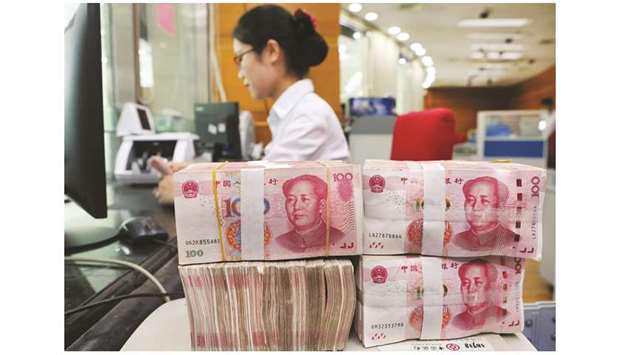China’s new bank loans likely rose in September but other key gauges of credit growth remained lacklustre, a Reuters poll showed, reinforcing expectations Beijing needs to deliver more support to stabilise the economy as trade pressures build.
Chinese regulators have been trying to boost bank lending and lower corporate financing costs for over a year, but the pick-up in loan growth has been modest compared to previous rounds of stimulus, and economic activity has continued to slow.
Analysts say the problem is not a lack of credit, but weakening business and consumer confidence as the US-China trade war drags on, weighing on activity from manufacturing and investment to retail sales.
Chinese banks are expected to have issued 1.4tn yuan ($196.02bn) in net new yuan loans last month, up 16% from 1.21tn yuan in August but largely in line with the tally in September last year, according to a median estimate in a Reuters survey of 30 economists.
Broad M2 supply was seen unchanged from 8.2% growth in August.
But growth of outstanding loans was expected to decelerate for a sixth straight month.
Annual growth of outstanding loans in September was seen edging down to 12.3% in September, the lowest since July 2002, from August’s 12.4%.
Some analysts say the annual comparison is a better way to assess trends in China’s credit growth, rather than more volatile monthly readings.
In a bid to boost bank lending, the central bank has pumped out trillions of yuan in liquidity by repeatedly cutting banks’ reserve requirement ratios (RRR) since early 2018.
But despite repeated calls by regulators to help struggling smaller, private firms, banks have been reluctant to lend as such firms are considered bigger credit risks.
Some factory managers have told Reuters they have lost financing or had their credit lines sharply cut back.
More recently, Chinese regulators have stepped up efforts to rein in mortgage lending amid concerns about property prices and rising household debt. Offsetting the modest pick-up in yuan loans, Reuters survey respondents expect total social financing (TSF), a broad measure of credit and liquidity in the economy, to drop to 1.8tn yuan in September from 1.98tn in August.
The expected decline is likely due to lower issuance of both corporate and local government special bonds.
Net issuance of local government bonds are estimated to fall notably as the provincial authorities are already close to exhausting their annual bond quotas.
TSF includes off-balance sheet forms of financing that exist outside the conventional bank lending system, such as initial public offerings, loans from trust companies and bond sales.
Analysts at Capital Economics noted problems with credit allocation will dampen the impact of stronger credit growth on the real economy.
“Private firms, which make up the bulk of shadow banking borrowers and low-rated corporate bond issuers, have benefited least from current round of monetary easing. And the share of credit going to less-efficient state firms has increased.”
Moody’s Investors Service said in a recent report that China’s shadow banking assets were near 3-year lows.
China’s central bank recently said it is in no rush to follow other countries in significantly loosening monetary policy but has ample options to help prop up slowing growth, suggesting a cautious approach to additional stimulus.
With an eye on debt, Beijing has been leaning more heavily on fiscal stimulus to weather the current downturn, announcing trillions of yuan in tax cuts and special local government bonds to finance infrastructure projects.
But analysts say continued credit support is needed, especially as more US tariff measures against China are set to take effect on October 15 and December 15, unless the two sides can agree on some form of de-escalation.
China and US top trade negotiators will meet in Washington for trade talks today and tomorrow.
But prospects for progress dimmed on Monday after Washington blacklisted Chinese companies over Beijing’s treatment of Muslim ethnic minorities, and President Donald Trump said a quick trade deal was unlikely. Analysts expect economic growth could cool further this quarter from a near 30-year low of 6.2% hit in April-June.
“Owing to rapidly falling industrial production growth, a slump in pork production and elevated US-China trade tensions, we expect the growth slowdown to gather pace,” economists at Nomura said in a recent note.
“We expect more policy easing/stimulus measures, including medium-term lending facility (MLF) rate and reserve requirement ratio (RRR) cuts through the rest of this year to stabilise market sentiment and bolster growth.”

An employee counts 100-yuan notes at a bank in Nantong, Jiangsu province. Chinese regulators have been trying to boost bank lending and lower corporate financing costs for over a year, but the pick-up in loan growth has been modest compared to previous rounds of stimulus, and economic activity has continued to slow.
